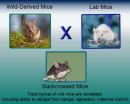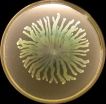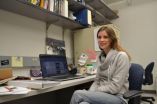(Press-News.org) A chance discovery about the 'wonder material' graphene – already exciting scientists because of its potential uses in electronics, energy storage and energy generation – takes it a step closer to being used in medicine and human health.
Researchers from Monash University have discovered that graphene oxide sheets can change structure to become liquid crystal droplets spontaneously and without any specialist equipment.
With graphene droplets now easy to produce, researchers say this opens up possibilities for its use in drug delivery and disease detection.
The findings, published in the journal ChemComm, build on existing knowledge about graphene. One of the thinnest and strongest materials known to man, graphene is a 2D sheet of carbon just one atom thick. With a 'honeycomb' structure the 'wonder material' is 100 times stronger than steel, highly conductive and flexible.
Dr Mainak Majumder from the Faculty of Engineering said because graphene droplets change their structure in response to the presence of an external magnetic field, it could be used for controlled drug release applications.
"Drug delivery systems tend to use magnetic particles which are very effective but they can't always be used because these particles can be toxic in certain physiological conditions," Dr Majumder said.
"In contrast, graphene doesn't contain any magnetic properties. This combined with the fact that we have proved it can be changed into liquid crystal simply and cheaply, strengthens the prospect that it may one day be used for a new kind of drug delivery system."
Usually atomisers and mechanical equipment are needed to change graphene into a spherical form. In this case all the team did was to put the graphene sheets in a solution to process it for industrial use. Under certain pH conditions they found that graphene behaves like a polymer - changing shape by itself.
First author of the paper, Ms Rachel Tkacz from the Faculty of Engineering, said the surprise discovery happened during routine tests.
"To be able to spontaneously change the structure of graphene from single sheets to a spherical assembly is hugely significant. No one thought that was possible. We've proved it is," Ms Tkacz said.
"Now we know that graphene-based assemblies can spontaneously change shape under certain conditions, we can apply this knowledge to see if it changes when exposed to toxins, potentially paving the way for new methods of disease detection as well."
Commonly used by jewelers, the team used an advanced version of a polarised light microscope based at the Marine Biological Laboratory, USA, to detect minute changes to grapheme.
Dr Majumder said collaborating with researchers internationally and accessing some of the most sophisticated equipment in the world, was instrumental to the breakthrough discovery.
"We used microscopes similar to the ones jewelers use to see the clarity of precious gems. The only difference is the ones we used are much more precise due to a sophisticated system of hardware and software. This provides us with crucial information about the organisation of graphene sheets, enabling us to recognise these unique structures," Dr Majumder said.
Dr Majumder and his team are working with graphite industry partner, Strategic Energy Resources Ltd and an expert in polarized light imaging, Dr. Rudolf Oldenbourg from the Marine Biological Laboratory, USA, to explore how this work can be translated and commercialised.
The research was made possible by an ARC Linkage grant awarded to Strategic Energy Resources Ltd and Monash University and was the first linkage grant for graphene research in Australia.
"We are so pleased to be associated with Dr Majumder's team at Monash university. The progress they have made with our joint project has been astonishing," he said.
INFORMATION:
The research was made possible by an ARC Linkage grant awarded to Strategic Energy Resources Ltd and Monash University and was the first linkage grant given to date for graphene research in Australia.
Surprise discovery could see graphene used to improve health
2014-08-05
ELSE PRESS RELEASES FROM THIS DATE:
Warning to parents on high acidity drinks
2014-08-05
Dental researchers at the University of Adelaide are warning parents of the dangers of soft drinks, fruit juice, sports drinks and other drinks high in acidity, which form part of a "triple-threat" of permanent damage to young people's teeth.
For the first time, researchers have been able to demonstrate that lifelong damage is caused by acidity to the teeth within the first 30 seconds of acid attack.
The researchers say drinks high in acidity combined with night-time tooth grinding and reflux can cause major, irreversible damage to young people's teeth.
"Dental erosion ...
Pheromones regulate aggression of non-mother female mice toward pups in wild-derived mice
2014-08-05
Laboratory mice are one of the most common animal models used in biological and medical research. Thousands of laboratory mouse strains are produced by artificial selection – the process by which humans breed animals over dozens of generations for particular traits. This has led to the domestication of mice: strengthening specific qualities that make them well-adapted for research under laboratory conditions, such as rapid reproduction, while eliminating characteristics that are not conducive to research, for example, aggression, the desire and ability to escape from danger, ...
Eating more dietary pulses can increase fullness, may help manage weight
2014-08-05
TORONTO, Aug. 5, 2014 – Eating about one serving a day of beans, peas, chickpeas or lentils can increase fullness, which may lead to better weight management and weight loss, a new study has found.
A systematic review and meta-analysis of all available clinical trials found that people felt 31 per cent fuller after eating on average 160 grams of dietary pulses compared with a control diet, according to senior author Dr. John Sievenpiper of St. Michael's Hospital's Clinical Nutrition and Risk Factor Modification Centre.
His group's findings were published in the August ...
Social networking is key to helping bugs spread, study shows
2014-08-05
Fresh discoveries about how bacteria co-operate with each other when causing infection could help scientists identify animal diseases that might transmit to people.
Bugs that can co-operate best with each other are most likely to be able to jump to new species, including humans, a new study shows.
Bacteria interact by releasing molecules to help them adapt to their environment – for example, when killing competing infections in their victim. They co-ordinate these actions by releasing tiny amounts of chemicals as signals.
Bacteria that can co-operate to create an ...
LEDs made from 'wonder material' perovskite
2014-08-05
A hybrid form of perovskite - the same type of material which has recently been found to make highly efficient solar cells that could one day replace silicon - has been used to make low-cost, easily manufactured LEDs, potentially opening up a wide range of commercial applications in future, such as flexible colour displays.
This particular class of semiconducting perovskites have generated excitement in the solar cell field over the past several years, after Professor Henry Snaith's group at Oxford University found them to be remarkably efficient at converting light to ...
Smart bacteria help each other survive
2014-08-05
The body's assailants are cleverer than previously thought. New research from Lund University in Sweden shows for the first time how bacteria in the airways can help each other replenish vital iron. The bacteria thereby increase their chances of survival, which can happen at the expense of the person's health.
The bacteria Haemophilus influenzae is a type of bacteria in the respiratory tract that can cause ear infections and worsen the prognosis for COPD patients. In rare cases, it can also lead to meningitis and septicaemia.
"By accepting help from a specific protein, ...
Carnegie Mellon photo editing tool enables object images to be manipulated in 3-D
2014-08-05
PITTSBURGH—Editors of photos routinely resize objects, or move them up, down or sideways, but Carnegie Mellon University researchers are adding an extra dimension to photo editing by enabling editors to turn or flip objects any way they want, even exposing surfaces not visible in the original photograph.
A chair in a photograph of a living room, for instance, can be turned around or even upside down in the photo, displaying sides of the chair that would have been hidden from the camera, yet appearing to be realistic.
This three-dimensional manipulation of objects in ...
Rituals can help older people remember to take their asthma meds
2014-08-05
Storing it in the bathroom and making it part of a daily routine may be helpful advice that doctors can give their older asthmatic patients who struggle to remember to take their daily prescribed medication. This advice comes from Alex Federman, Associate Professor of Medicine at the Icahn School of Medicine in New York City, senior author of a study which discusses how elderly asthmatics cope with taking their inhaled corticosteroid medication as prescribed. The findings appear in the Journal of General Internal Medicine, published by Springer.
The regular use of such ...
Clues to the ageing of tendons unlocked for the first time
2014-08-05
University of Liverpool scientists have examined the mechanisms that cause ageing in the tendons of horses, opening up the possibility of better treatment for humans.
It has been understood for many years that tendons are highly prone to injury and that this likelihood increases as they age. Why this happens, is currently poorly understood
Now, using samples taken from young and old horses, which have similar tendon properties to those of humans, the team of researchers, which also included scientists from Queen Mary University of London, performed a range of tests ...
Scientists call for increased conservation efforts to save black bears
2014-08-05
COLUMBIA, Mo. – Between 1880 and 1920, the Central Interior Highlands (CIH), consisting of Missouri, Oklahoma and Arkansas, saw the height of deforestation that also decreased the habitat for black bears and other forest species. To combat the decline of black bears and repopulate the mountainous region, more than 250 bears from Minnesota and Manitoba were relocated to Arkansas in the 1950s and 1960s. Now, researchers at the University of Missouri have analyzed genetic diversity in black bears in the CIH and have determined that coordinated conservation management is still ...





